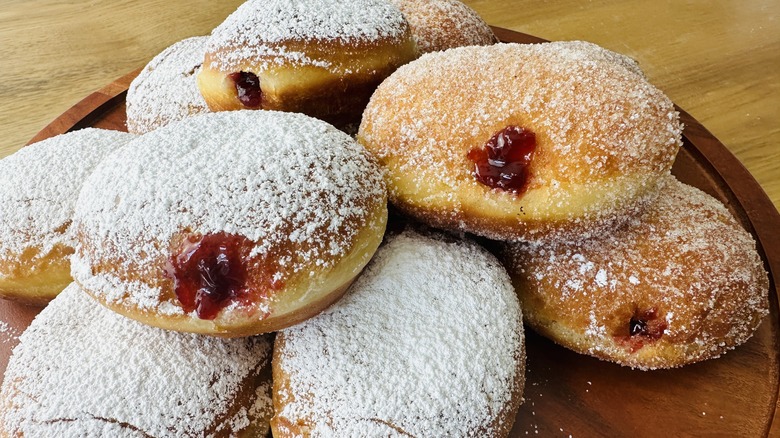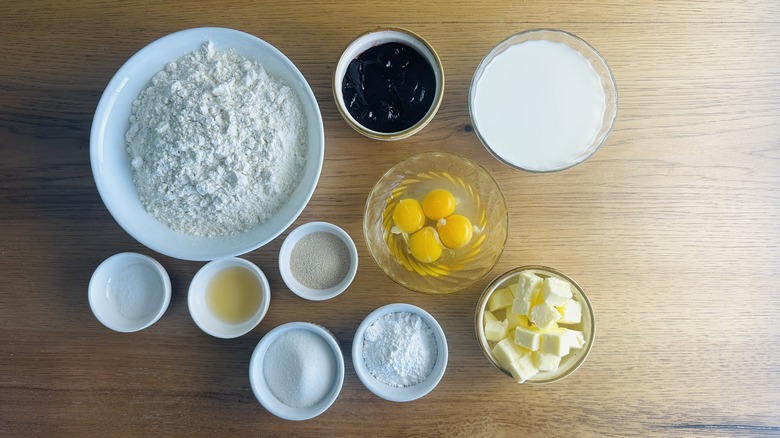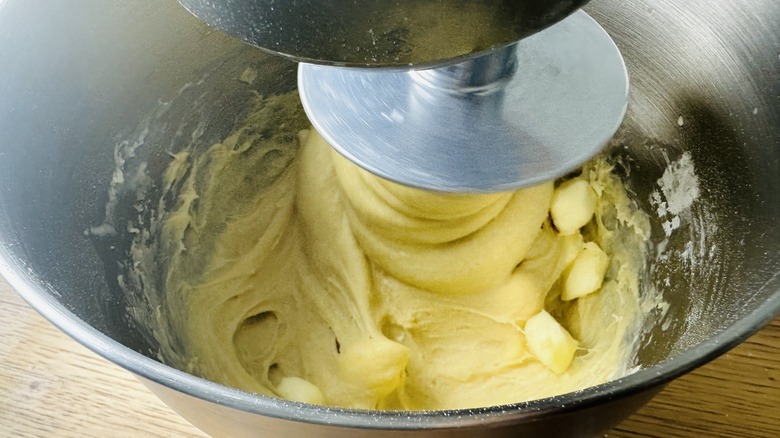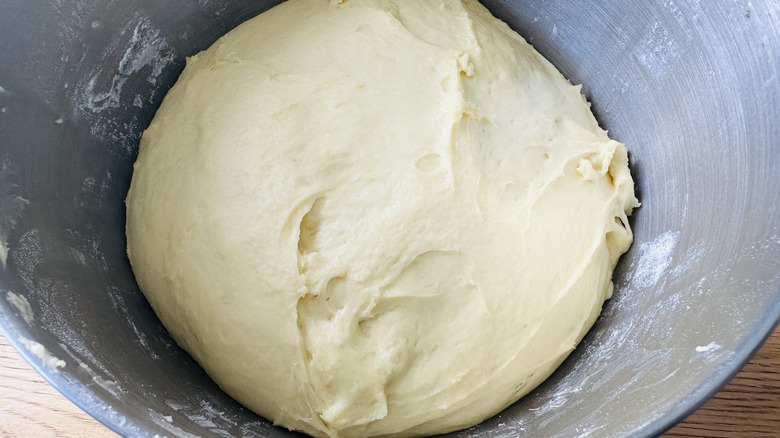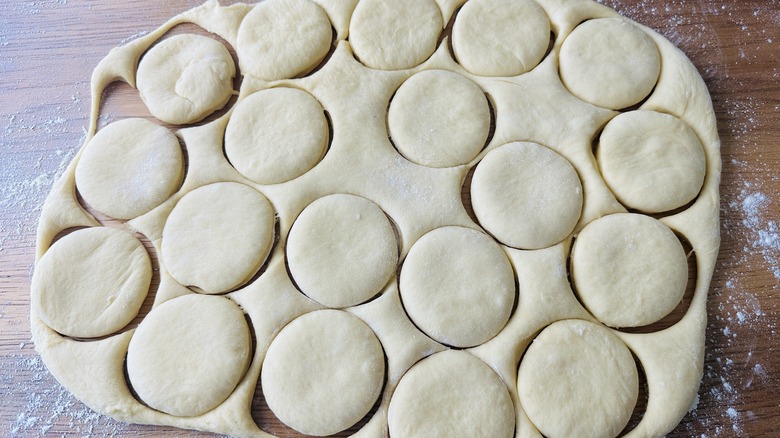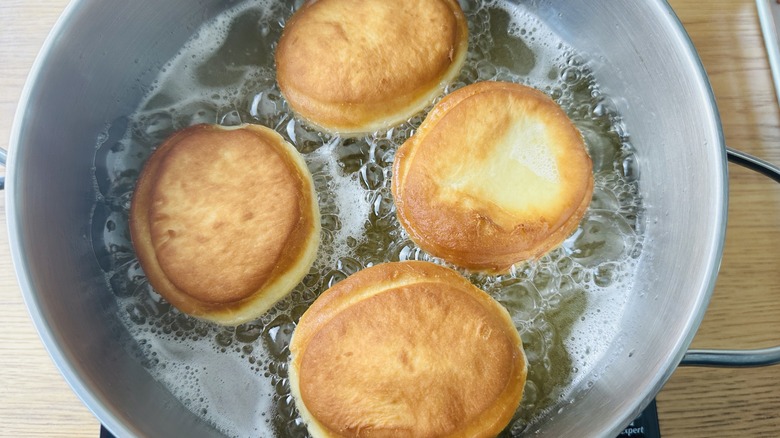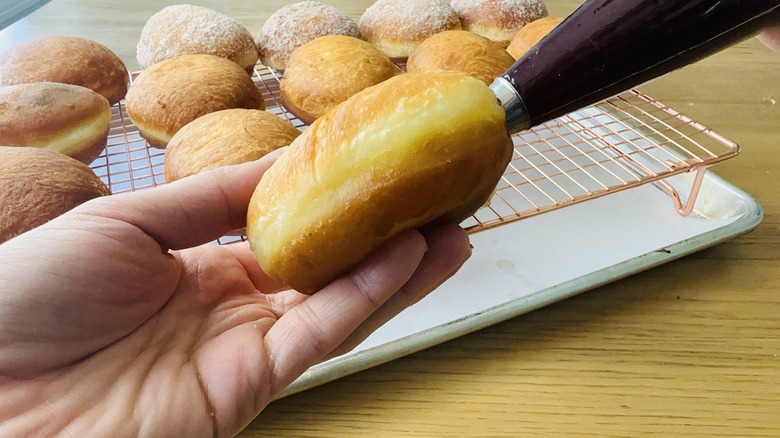Raspberry-Filled Polish Paczki (Doughnuts) Recipe
While pączki may not be too well-known in some parts of the U.S., these jelly-filled doughnuts are pretty popular in any area with a large population of Polish descent. In fact, in many major metropolitan areas such as Milwaukee, Fat Tuesday/Mardi Gras actually goes by the name of Pączki Day and is devoted to standing in line at a bakery to stock up on these sweet treats before consuming as many as possible. Another holiday when pączki is always on the menu is Dyngus Day, an after-Easter celebration of Polish culture in Buffalo, New York.
If you're not familiar with the Polish take on jelly doughnuts, recipe developer Katie Rosenhouse describes them as "light and airy" with "just enough sugar to balance the dough without competing with the sweetness of the jam filling." While she admits that glazed or powdered sugar-sprinkled pączki are traditional, she tells us, "I love mine dredged in cinnamon sugar" so she's including that as an option here. If cinnamon sounds good to you but you don't feel that it pairs too well with raspberry, she does say that you can really use any type of jam or even a custard filling. This means that you could fill the doughnuts with something like apple butter, instead.
Gather the ingredients for the raspberry-filled Polish pączki (doughnuts)
To make the pączki dough, you'll need milk, yeast, granulated sugar, eggs (whole ones plus a few extra yolks), salt, flour, and butter. You're also going to need a neutral, high smoke point oil such as canola or vegetable for frying, plus some jam for filling and some powdered sugar (or cinnamon sugar) to sprinkle over the top of the doughnuts once they're done.
Make the dough
Heat up the milk until it's just lukewarm –- if you're using a thermometer, it should read anywhere between 105 and 110 F. Mix in the yeast and a teaspoon of sugar, then cover up the mixture with a piece of plastic wrap or a clean towel. Let it sit for 10 minutes so it can foam up, then stir in the rest of the sugar plus the eggs (extra yolks included), salt, and 5 ¼ cups of flour.
You can also stir in a tablespoon of vodka or rum at this point, although it's not necessary to do so. The booze won't be adding much flavor to the dough, but Rosenhouse does say that some people believe this addition may reduce the amount of oil soaked up by the pączki as they fry.
Knead the dough
Knead the dough until it's smooth. If you are using a stand mixer to knead, use the low speed and the dough hook and count on the process taking about 5 to 6 minutes. If you're going old-school and kneading by hand, it might take a bit longer. If the dough is sticky, add a tablespoon at a time of the remaining flour, but don't be too quick to do so. Rosenhouse notes that this extra flour "will change the final texture of your doughnuts," but says that as you continue to knead, the dough will develop gluten on its own and become less sticky.
Once the dough is sufficiently un-sticky, start adding the butter a pat at a time, Keep kneading for another 4 to 5 minutes until all the butter is in the dough and the dough had a nice uniform consistency. Cover the dough with a clean towel or plastic wrap, then let it sit for 60 to 90 minutes until the volume has doubled.
Shape the pączki
Roll out the dough on a surface sprinkled with a light dusting of flour. When the dough is ½-inch thick, cut it out into 3-inch circles. If you have no suitably-sized cookie or biscuit cutter, a drinking glass will work just fine. Take your dough rounds and put them on a baking sheet or similar flat surface, preferably paper-covered and/or flour-dusted to prevent them from sticking. Cover them with a towel or plastic wrap and let them rise once more for about 30 to 45 minutes until they get puffy. When you poke the dough at this point, it should bounce back like a marshmallow.
Fry the pączki
Fill a heavy pot or deep fryer with 2 to 3 inches of oil and heat it to 350 F. Fry the doughnuts in batches of 2 to 4, depending on how large your pot is, then flip them over and keep cooking them until they are golden brown on both sides. If they brown too quickly, turn down the heat. If the first batch doesn't turn out quite right (too heavy or too brown), Rosenhouse suggests that you might want to turn off the heat and let the rest of the doughnuts rise for more time before you attempt to fry a second batch.
Once the doughnuts are cooked, if you prefer a cinnamon sugar coating you should apply it right away while they're still hot. If you're team powdered sugar, though, they'll need to cool down first.
Fill the pączki
When the pączki are all cooked and cooled, they'll need to be filled. If you have a piping bag, with a star or filling tip, use this to insert the jam. If you don't, you can use a Ziploc bag with the corner snipped off. In this case, though, you'll need to cut or poke a hole into each doughnut in order to insert the jam. When each doughnut is filled, sprinkle it with powdered sugar. (Or not, if you already applied cinnamon.)
"These are definitely best the day of frying," Rosenhouse says, but you might not be able to consume 24 jelly doughnuts in the space of a single day. That's okay, though, since you can always freeze the leftovers, then heat one or two up in a 400 F oven for a few minutes the next time you want a sweet snack.
Raspberry-Filled Polish Paczki (Doughnuts) Recipe
These raspberry-filled Polish pączki will definitely take some time in the kitchen, but the fresh, doughnut-y goodness will be well worth the effort.
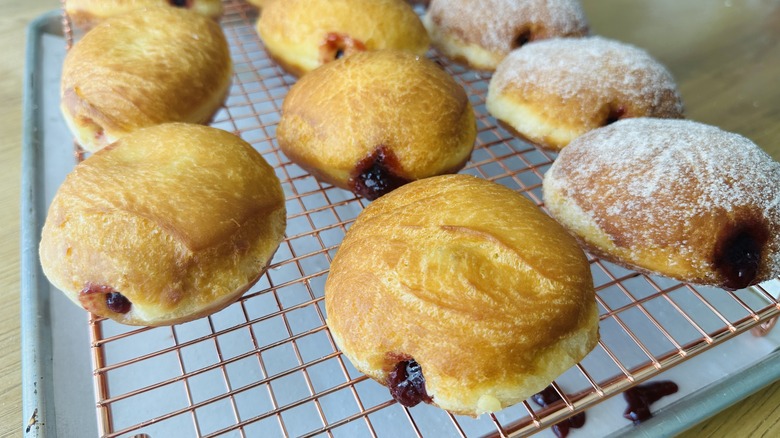
Ingredients
- 1 ¼ cups whole milk
- 4 ½ teaspoons (2 packets) active dry yeast
- ½ cup granulated sugar, divided
- 2 large eggs + 2 large egg yolks
- 2 teaspoons kosher salt
- 5 ½ cups all-purpose flour, divided
- ½ cup unsalted butter at room temperature
- vegetable or canola oil, for frying
- 1 (18-ounce) jar seedless raspberry jam
- ¾ cup confectioners' sugar or cinnamon sugar
Optional Ingredients
- 1 tablespoon vodka or rum
Directions
- Warm the milk on the stove or in the microwave until lukewarm (105 to 110 F).
- Combine the milk with the yeast and 1 teaspoon of sugar, then cover this mixture with plastic wrap or a towel and let it sit for 10 minutes until it becomes foamy.
- Stir the remaining sugar into the yeast mixture along with the eggs, yolks, salt, 5 ¼ cups flour, and vodka or rum if using.
- Using a stand mixer with the dough hook attachment, knead the dough for 5-6 minutes on low speed. If dough is sticky, add remaining flour a tablespoon at a time until workable.
- Slowly add the butter to the dough, a pat at a time, kneading it for 4-5 minutes until all of the butter has been added and the dough appears uniform.
- Cover the dough with plastic wrap or a towel and allow it to rise for 60 to 90 minutes until it doubles in volume.
- Roll out the dough on a lightly floured surface to a ½-inch thickness.
- Cut the dough into 3-inch rounds using a cookie cutter or the rim of a glass.
- Set the dough rounds on a parchment paper-covered and/or lightly floured surface and cover them with plastic wrap or a towel.
- Let the dough rise for 30 to 45 minutes until it becomes puffy and has a marshmallow-like texture when poked.
- Heat 2-3 inches of oil to 350 F over low heat.
- Fry 2 to 4 doughnuts at a time, depending on the size of the pot, for 2 or 3 minutes, then flip them over and cook them until they are golden brown all over (lower the heat if they brown too quickly).
- If you're dipping the doughnuts in cinnamon sugar, do so while they are still hot, then let them cool.
- Once all of the doughnuts are cooked and cooled, use a piping bag or a Ziploc with a corner snipped off to fill them with jam. If using a piping bag, the tip will poke the necessary hole. If using a ziploc, you'll need to make a small incision in each doughnut to insert the filling.
- Sprinkle the filled doughnuts with powdered sugar, if using.
- Serve the pączki right away, while fresh.
